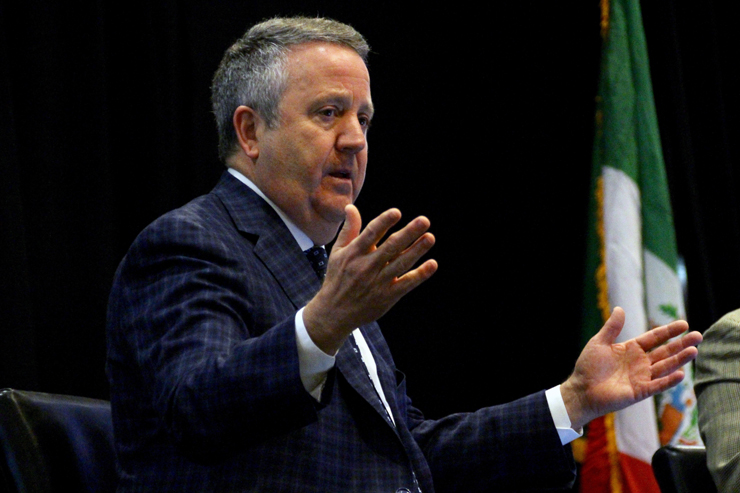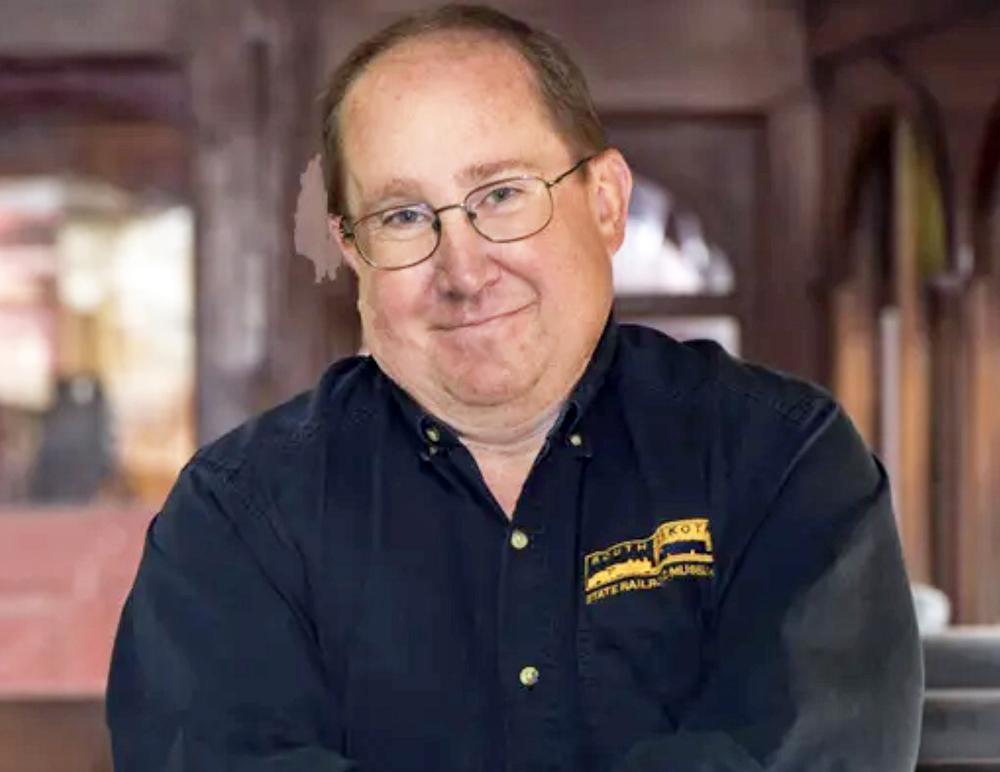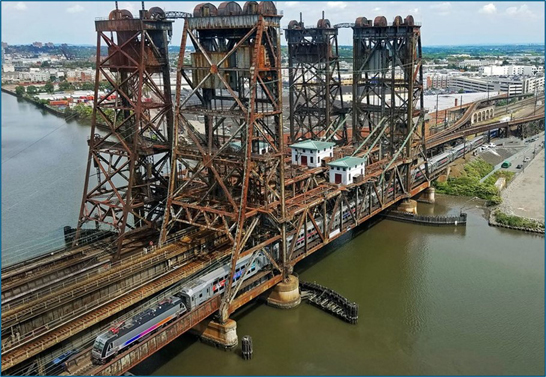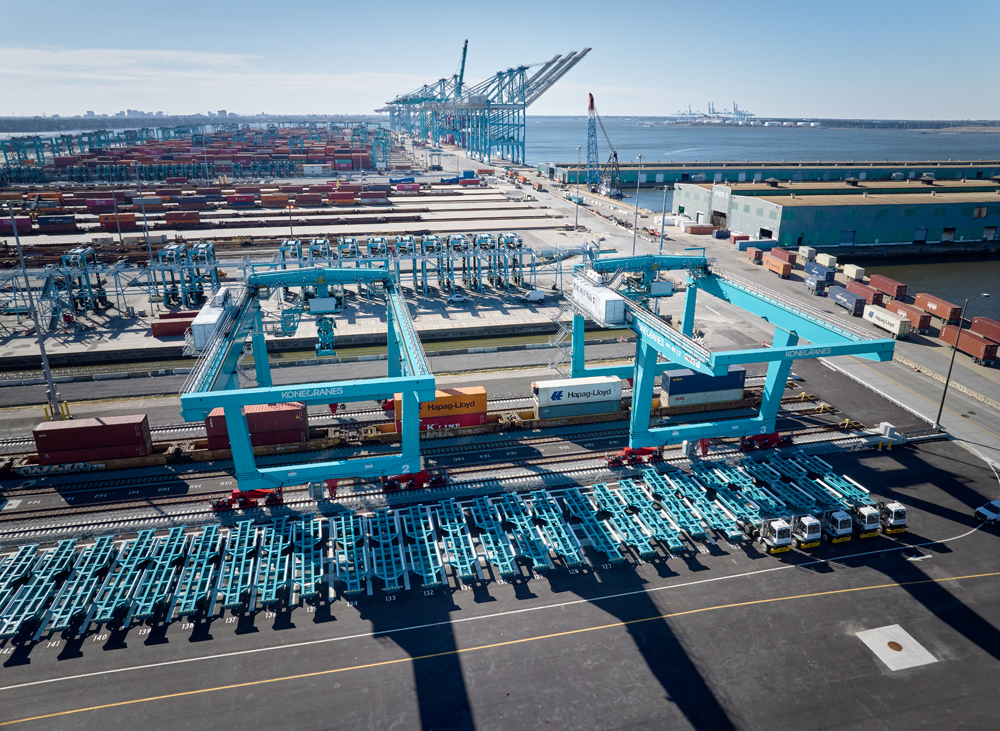“If there’s one regret I have, it’s that we haven’t made more progress in automation in the cab and the crew,” Rose says.
The last major step in that regard, was the 1986 agreement that allowed reduction from five-man crews to the current average of 2.2 crew members. Railroads, he said, must be able to achieve the same level of automation as trucks.
“We’ve got to be able to achieve those same levels of productivity on the railroad, or else our spread between the highway and the rail will get narrower and narrower, and we’ll lose more traffic to the highway. … In the trucking industry, it’s a ginormous opportunity, so they’re going to invest a lot to facilitate the automation,” Rose says.
Such automation, he noted, will come in steps: first through platooning, with trucks with drivers operating closely together.
“That’s worth 6 to 8 percent of fuel savings,” Rose says.
Next will come platoons with drivers in the lead vehicle and attendants, rather than full-fledged drivers, in the following trucks; followed by platoons with a driver in the lead vehicle and fully automated vehicles following.
“Each one of those stair steps down takes away our spread between us and the trucking industry,” he says. “And that’s why we’ve got to stay with them one by one. And yet, the perfect place to do automation in our surface transportation industry is the railroad industry. It’s a private industry. It doesn’t have the amount of stuff that the highway does, in terms of people walking in front of cars and things like that.
“And yet, literally, in D.C., our favorite place, you’ve got people that are running two-person-crew bills, to require each railroad to maintain two people in the cab of a locomotive. It’s insane. We’re going to pass trucking regulation … to facilitate the advent of autonomous trucks, and then we’re going to then require the railroads to have minimum staffing? It makes no sense.
“So we’ve got to keep working on automation.”
Trains editors are covering the Midwest Association of Rail Shippers conference from Lombard this week. More information on the conference is available online.















Why do we keep getting compared to truck drivers? There’s no comparison besides we haul containers that have goods. Us trainmen haul 200+ containers in one trip that’s about a 7k ft train. They are building more 12k and 16ks now which is well over 200 containers.
It feels great having one of our “bosses” talk about replacing our job. If he wants to become more efficient spend the money to get the dispatchers state of the art software that makes it near impossible to delay trains. They delay more trains on the Transcon than maintenance and track failure. If a Z9 is anywhere within 100 miles they will stop and kill 10 trains just to save that Z train 10 minutes. Also the chief dispatchers micro manage all the dispatchers and they don’t call dog catch or chase crews when they should causing more delays. But NO, blame the train crews as the big wigs always do.
Like some of these people have said Matty boy I bet you’ve never rode a manifest train that gets delayed by dispatchers or maintenance, or switched out cars. You only ride your hot shot officer trains but guess what they are run by actual people that handle trains so well you are able to drink your fruity drinks.
For the people that are arrogant saying trains should already be automated by now it’s so easy. Hauling thousands of tonnage isn’t like pushing the gas and brake on a Prius. The earth isn’t flat so the terrain and grade is a major factor.
Trains now are semi-automated. We have a GE Trip Optimizer on almost every locomotive which works as a fuel saving cruise control. It will throttle and use dynamic brakes, it recommends using air (entire train brakes) to the engineer if the dynamic brakes aren’t strong enough to hold the train at the speed limit. Here’s a link.
https://www.ge.com/digital/sites/default/files/download_assets/GE-Transportation-Trip-Optimizer-20160824.pdf
Also BNSF has PTC (positive train control) on just about every motor. I hardly ever have a trip without it and if it’s an originating station (where the train is built) PTC is require to be on the lead motor. This tool not only helps us be safer and will stop trains if us humans god forbid ever make a mistake. It also made the railroad a lot more efficient in CTC controlled territory. In foggy, snowy or poor visibility we can look to the screen and see if we are lined up or have to stop. Before we’d have to slow down tremendously. Worried what the next signal would be in 10 feet visibility conditions. Also we can see on the PTC screen if we are following a train and assuming they are only a 55mph train match their speed and continue on maximizing train spacing.
Just remember a intermodal train from Chicago to LA crew swaps at 8 stations (L.A., Needles, Winslow, Belen, Amarillo, Wellington, Kansas City, Chicago) for a total of 16 people (engineers & conductors) hauling 200+ containers where as truckers haul 1. We don’t get paid per container we get paid by the mile. So tell me again how 2 man crews are costing you so much money that you can’t compete with the trucking industry even if they go automated and have 10 robot trucks following the “platoon leader” as you stated. We just have to look through all the smoke you’re blowing and see the main objective is not to be “safer” but to fatten your pockets even more.
Shame on you Matt,
-Taylor
BNSF should be lobbying against the obviously unsafe technology of automated trucking rather than using it as an excuse to cut their own workforce.
Recognize duplicity when you see it! Matt rose is a modern day Robber Baron.
Imagine automation of an individual freight car. It would eliminate probably the biggest cost in moving rail by freight: switching cars in the customer’s yard tracks, and switching cars in the freight yard. You could still attach these cars to mainline trains and run them the usual way, even automatically attaching them to existing freight trains. Having a small motor on a freight car so it could move on its own would be a cost, but the big advantage is the car could go when its ready to go, thus increasing reliability and overall door to door transit time, which is a huge advantage for all the short distance, time sensitive freight that the railroads just don’t have much of these days, but generally costs more to move on a per lb or ton basis.
Now, apply this to passenger trains too, especially big city subway and light rail transit systems, and you can transform them as well from a system that requires constant subsidy to one that covers most of their costs with the farebox.
The Japanese New Tokkaido line from Tokyo to Kyoto and beyond was fully automated when it opened in 1965. An operating crew of 2 was aboard to brake or stop the train in the event of an obstruction or other emergency. Having ridden the train in 1968, I can attest that operation was remarkably smooth even at 125mph. This facility is of course in no way comparable to U..S. freight operations, with its complete grade separation and closed right of way. Still, I think it demonstrates what can be done as an adjunct to current practice, particularly in the area of safety. In adverse circumstances, a pair of clear eyes, swift reflexes and experience can’t be displaced by automation. It’s possible that remote operation might displace some personnel, but who wants to risk a $20 million train on comm gear that’s subject to interruption or may not be sensitive enough to detect a maturing problem. I think a more productive area of concern would be developing an electronic braking system that would be instantaneously responsive to a crewman’s action , yet cost effective enough to be feasible. Prototypes to date have shown promise but are too expensive. I have to believe an economical add-on can be developed.
What a crock; I keep hoping BNSF is not going to repeat the Wall Street chant of automated trucking.
I drove for a company flatbedding structural steel products in 11 states surrounding Oklahoma.
First;a large percentage of trucks on the interstate are making deliveries within a 1 to 3 hundred mile radius.
Imagine a tractor trailer full of loose structural steel that must be tarped in weather pulling into the lot of a small fabrication shop and somehow knowing where in the yard the customer wants to unload the product; then if the driverless truck can be spotted; who untarps the load and figures out where the customer’s steel is on the trailer and then rechains and retarps the load for the continued trip to the next customer of perhaps 5 on that load.
Imagine being a BNSF crew out of Needles heading east with hundreds of containers; that on the road would require a driver for at least every 2 containers; hearing that he is featherbedding like the firemen of the early diesel period.
I really do not think that the public is going to stand for platooned trucks;; try passing a set of Turkpike tripples in the rain and you are blind for most of the pass.
Also states and what is left of the federal government is not going to fund all the changes to make the robot vehicles work. Oklahoma rarely restripes roads until the stripe has been invisible for about 5 years.and many of the robot vehicles use this to stay in the lane.
Come on Matt; you know better.
All of this talk of automation is great but then who will have a job to pay for any of the stuff that trucks and trains haul?
The train simulation programs have AI trains that mimic the movements of the staffed trains we know and do it quite well. So that tells me it is possible.
As for using trucks in a terrorist attack, well that has already been going on for a long time (for example, Oklahoma City) with drivers. In fact road vehicles account for around 70% of terrorist attacks worldwide.
. . . flying cars and self-driving trains. And we’ll rebuild America overnight to run without coal power.
I agree!
I think the thing that will stop driverless trucks , is the fear of their use in a terrorist attack.
Self driving trucks needs to be filed away with flying cars.
Reminds me of when local agents were replaced by mobile agents. Business left on branch lines across the nation because the man down at the local depot was now gone.
As far as Highways go, it is the increased passenger car volume that requires more than 2 lanes in each direction in many places. But unless something has dramatically changed in about 3 years since I last talked to some of the leading highway researchers at the PA Transportation Institute, it is the heavy trucks that are pounding the roads and stressing out the bridges of all sizes, more so where winter weather comes into play. The last I heard was that the Trucks would have to pay about 3 or 4 times more in taxes (depends on where they buy their diesel) what they are currently paying to cover all the damage they are causing. Of course, reducing their allowed weight would be highly beneficial and would proportionately reduce the needed increased taxes on their part. The downside would be the increased cost passed on to the customer. If you are a labor person the upside would be the need for more drivers. It appears right now that driverless trucks on non-dedicated highways is a long way off. For one thing, any serious accident due to driverless vehicles will result in huge payouts to the injured given current civil law trial results. That’s one thing I never hear mentioned by the advocates of driverless vehicles (or automatic train operation).
There are other ways to reduce highway costs. One of the easiest is to modify the prevailing wage laws so that the workers are being paid their normal wage, not some artificial figure where they make 50% or more of their normal pay just because its a government contract. Another is to make the highway standards better when the roads are first built. In many urban areas and certain states its also making sure any contractors and workers are not tied to or run by organized crime. The train Tunnels projects in the greater NYC area also would cost much less and be completed a lot faster if these changes, plus eliminating the bloated construction crew requirements, would occur.
My personal thoughts regarding 2 man crews in todays world is any LD train that has 2 man then should have a crew consisting of a senior engineer and another qualified engineer. That way they can switch off and eliminate some of the fatigue factor on their long runs. If only one engineer is going to be on the LD train, he should have an hour off for every approximate 4 hours [or 5 hours at the most] that he’s operating the train to also avoid the fatigue factor.
Gerald Mc: your fuel tax breakdown according to the size of the vehicle seems reasonable on the surface. So many people think people driving SUV’s or pick-ups don’t need to. This may be true for some, but then there are some of us that haul equipment that would never fit in a car. But there is one category you left out. How do you collect taxes from electric cars? Or hybrid cars that use little gas? Do you charge them higher vehicle registration fees? With all vehicles getting better gas milege, gas tax revenue is going down. Something has to give if we want to maintain our current highway system.
In 2008 I was shown a photo of locomotives at GE Erie that included some new units. However, there was a UP unit that was fitted with the same external “Autohaul” eqipment boxes that I had seen on Australian Rio Tinto Dash 9s used for testing their remote control equipment. This was a box as high as the front handrails that sat in the space for the front gangway which was connected by cables to the front MU connectors. There was also an antenna monted to the nose near the front entry door. SO UP have been testing remote control for more than ten years.
Trains need more automation loading and unloading freight, making trains quicker (not necessarily faster) between more cities and actually competing with trucking. Coal and petroleum are fading industries, and RRs depending upon them will also fade.
Translated “automation” means money which once went to labor now will go into fat cat’s pockets. Like years ago when some fat cat executive realized that money required to paint equipment in attractive paint schemes needed to be going into fat cat pockets.
Common sense would tell you that ALL fuel taxes need to be quadrupled at a minimum to first repair our highway system to an adequate level, then just to maintain it going forward. Better yet, restructure the entire fuel tax and create 3 new ones at the same time: minimum of $1 for passenger vehicles, $1.25 – $1.50 for SUVs and pickups; $1.75- $2.00 for OTR(both short haul and long haul) diesel; $.50 per barrel of diesel for bulk purchasers(aka railroads) with the money deposited into the newly created Railroad Tax Fund(exclusive use for railroad related expenses and Amtrak); $.75 – $1.00 for waterborne vehicles paid into the newly created Waterways Preservation Fund(or something like that). Oh, and change the weight limit for OTR movements as follows, anything that travels over 500 miles via railroad can be loaded up to 90000 GVR, less and the max remains the same 80000 GVR.
Keep in mind there is another factor that goes into road design besides the weight of the vehicles and that is the number of vehicles. While truck weight controls the strength of the road, cars are the main factor in how many lanes a road needs. One simplified way to look at it is that gas tax pays for most of the road and diesel tax pays for the extra strength.
Highways designed for automobiles require about 2″ of roadway thickness. Include trucks and the requirement soars to 8″. There is no way trucking pays its fair share. And, government provides a paved conduit between any two truck docks in the nation. If only the rails were so lucky with sidings.
Noel Petit… Get on the road and become an Owner/Operator.. Then let me see you talk about who pays what? Quit crying about trucks don’t pay this or that.. Cause this amount of damage.. Personal vehicles don’t pay anything for highways maintenance if that’s the case?? The highway fund is about drained. So what does all that so called gas tax fund? Don’t blame trucking because of an open acess highway system the public funded, that can’t return it’s true operating cost through tax recovery at the pump….
The legal limit ttruck weights 4.5 tons/axle. Most cars weigh 2 tons/axle (and are getting lighter). Why does the truck get to pound the road so much more than the car?
Mr. Rose! Get REAL – you’ve had many years to push forward automation and you simply did not!!! What is your excuse? What is insane, is crew-less trains! Curious too, have you ever operated a train? Been a part of a train crew or MOW crew? Worked with Carmen and/or Rapid Responder? . . . I thought not.
Again, you’re acting as if two-person crews is the ONLY barrier stopping full-on automation. Here is one for you – all your statistics and research indicates (supposedly) why automation is such a grand idea – how about setting out to disprove your own hypothesis? Now, there is an idea – and good science, too.
Jim and Steve – still awaiting a report – good journalism – stating why automation is a bad idea. And, why is replacing humans THE cost-saving measure that stands in the way of automation? Does some other cost-saving measure warrant investigation? Is it highly possible that room exists for both?
Jim and Noel hit the nail “ nails’ on the head. Also before railroads go after cutting cost with automation they need to start selling the services they have and not turning away business trucks that doesn’t make the profit margin they want.
Trains have a 4 to 1 advantage over trucks in the cost of fuel per ton-mile. Trucks and trains without drivers will still have that advantage that no amount of automation will overcome. The problem is that we all subsidize trucks by our gas tax. Trucks do most of the highway damage and yet cars repair that damage. If trucks paid proportional to their weight and road damage they could never threaten rail as an efficient system. What Rose needs is a stronger lobby to force trucks to pay their way.
This is always the result of a private industry competing against subsidized (semi-private) trucking. Sorry for the pun.
Go after the elephant in the room Mr. Rose and stop trying to get more efficiency out of a completely efficient industry.